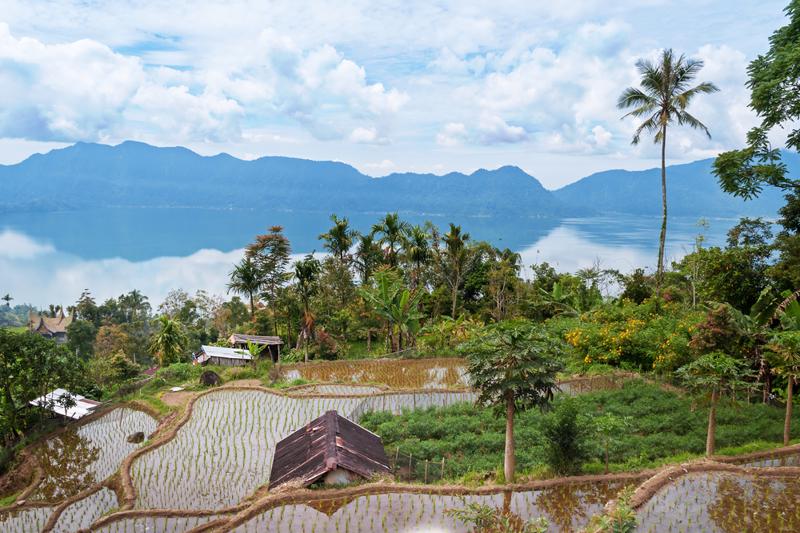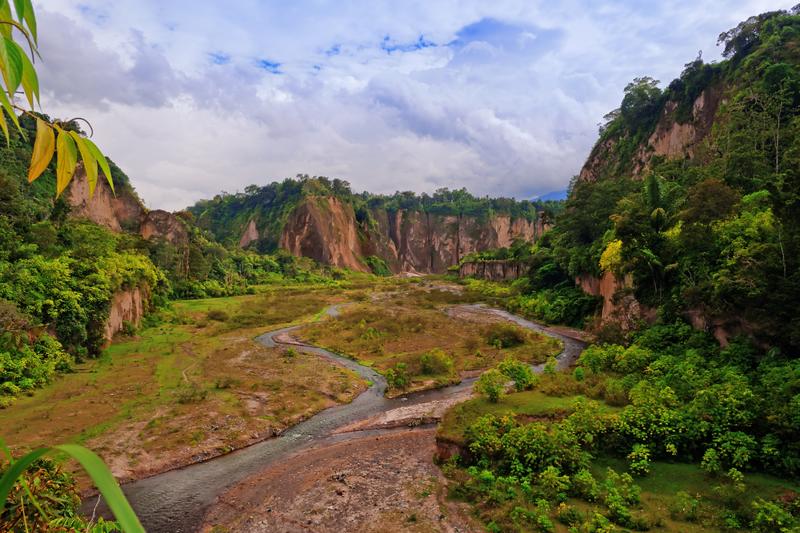“I’m an explorer.”
“A real one? I didn’t’ think they existed anymore or there was any place left to explore.”
“No. I am. I go off into the mountains of Western Sumatra, where people have not been and find what is there. I have to take my big knife,” Arlen swept his hands through the air in a machete chopping gesture, “so I can make my own path through the jungle. A real explorer.“
“What are you finding?”
“Different things. Sometimes for the government or to make new maps or just for fun.”

Arlen mesmerized me with his explorer’s tale as we sat on a grassy clearing in the middle of the West Sumatran jungle having lunch.
Bukittingi, Sumatra

Located on the Indonesian Island of Sumatera, Bukittinggi is the province of West Sumatera, 90km from the capital of the region.
Two volcanoes, Mount Marapi and Mount Singgalang are near the city and offer great opportunities for hiking and outdoor activities.
We had come to explore the nearby jungle after having a fun two day trek in Bukit Lawang with wild orangutans a few weeks before.
We arrived in Bukittingi intending to stay for a couple of nights, but stayed for 2 weeks as we were drawn into a romance with this matriarchal Muslim community.
We had met Arlen at the cafe/bar/restaurant across the road from our hostel in Bukkitingi.
The workers at our little hideaway loved serving us our favourite Indonesian tea sweetened with condensed milk during the day, and smuggled bottles of whiskey at night.
Each day we arrived for breakfast, they had a new adventured planned to encourage us to stay.
Which led us to our second Sumatran jungle trek adventure with Arlen.
Jungle Trek Bukittingi to Lake Maninjau

My two girlfriends and I had left early that morning for a two day jungle trek from Bukittingi to Lake Maninjau where we would end up staying for close to a week.
Lake Maninjau is a large crater lake bordered by several small villages. We enjoyed our time here soaking up the slow rural life recovering from our hike with plenty of swims, delicious home cooked meals from our guesthouse and games of shithead.
Our jungle trek with Arlen was one of them and I now felt a little more secure knowing that my guide into the great wilderness was an explorer.
In fact I was downright excited.
It was stories of explorers that began in my year 4 history classes that first ignited a thirst and passion for me to have similar experiences and explore the world myself.
But, I always felt that “real” explorers no longer existed because everything was already found. Well not in Indonesia.
My adventures with Arlen and the inspiration I gained from listening to his exploration stories came at the beginning of my overseas travelling life, in 1997 during my first trip abroad in Indonesia.
It is incredible how even though it was 14 years ago, I still remember Arlen and my time with him almost as if it were yesterday.
There are some people you meet on your travels who will have that lasting impact upon you, and the passing of the years will never fade away the memories they helped you to create.
I was soon able to see some of Arlen’s jungle skills put to the test.

The trek took us through the 15km Sianok Canyon, a popular attraction just outside Bukittinggi.
Sheer 100-120m cliffs face each across the Sianok River which meanders lazily along the 15km canyon banked by lush green foliage.
The scenery was spectacular and we had it all to ourselves.
Well maybe not….
After about an hour lunch break, we packed up our supplies and started our trek again. Just around the corner from where we sat was a small river we now had to cross.
Suddenly, Arlen put up his hand to signal us to be quiet and take a step back. His urgency did not invite me to question, only to do.
He ran forward, bent down and put his hand over a spot on the sandy banks.
“Been gone for about an hour.” he stated quickly and breathed. “It is okay.”
“What has been gone?”
We moved forward to where he was standing and looked down. There clearly imprinted in the sand was the gigantic paw print of a tiger.
“A tiger.” he said “was here about an hour ago, drinking from this river.”

He nodded, confirming what we were all thinking. …. if we didn’t stop for lunch.
I swallowed. Hard. My knees went incredibly weak.
“How do you know it was an hour?”
“I can feel the heat rising off the paw print. It lets me know it was about that time. Here feel it.”
I was almost afraid to put my hand over it in case it magically conjured the tiger up out of the bushes. Sure enough, a warm heat radiated out from it.
“The only thing is I don’t know where it has gone. Hopefully that way” he said pointing off into the opposite direction to where we were headed.
I hoped so as well, but wasn’t so sure as that way went through the clearing where we sat. Surely we would have seen it.
My dream of being an explorer suddenly felt really stupid. (Even more so a few weeks later when my mum informed me that a couple of people were killed by a tiger trekking through the jungle in the same area we were in.)
I really did not enjoy the rest of the walk and I could sense some tension from Arlen. I held tightly to the St Christopher medal that hung around my neck.
That was at a time when I had not yet questioned the beliefs and traditions of my own upbringing. I wore it, not because I believed it would protect me, but more out of fear of it not.
That fear and the medal no longer circle my neck.
The walk, which had this morning been quite calm and gentle, now turned strenuous along the steep and rocky, muddy paths.
I was beyond relieved when we reached the top of the mountain and entered into farmlands and Arlen suggested we jump in the back of the passing pick up truck and catch a ride the rest of the way.
Whatever you say dear explorer friend.
That evening a vicious headache spread up from the tension of my neck. Arlen sat with me and taught me how to relieve headaches through the use of certain pressure points in my body.
I had learned my first natural remedies for sickness while travelling. He had been kind enough to pull the leeches from our skin only hours before as we raced down the slippery mountain to reach our guesthouse in time for the monkey feeding.
We sat around and laughed and joked, while Arlen and his travelling companion, Buddhi, who could not speak a word of English but wore a constant smile, strummed the guitar and sang us Indonesian songs.
The next morning, feeling slightly refreshed, we made our way mostly downhill to our guesthouse on the Lake. The panoramic view on Lake Maninjau along the way was spectacular.
Although a difficult trek, it was a memorable one, and just one of the experiences on my first trip abroad that pulled me in to constantly seek a life filled with adventure and inspirational people that touched and evolved my spirit.
Remote island getaways
Our adventures with Arlen did not end there in the Sumatran jungle. We were convinced once again to take another exploratory trip.
This time to nearby remote islands perfect for snorkelling and swimming. I had no idea where we were and could not direct you. And I do not have any photos! This was way before the internet even and photos were just quick snapshots I took on a point and shoot film camera. Those are in a box somewhere in my mother-in-laws garage!
We just followed and trusted Arlen, who once again was not wrong.
These were true deserted islands that we had all to ourselves. We went back to primitive basics: no running water, electricity or even a bed to sleep in.
But that’s okay, we had Arlen, soft sand, and pristine views.
Arlen caught fish for our dinner, while we swam around exploring the delightful and abundant underwater world. We ate with our hands and washed up with ocean water.
Our evening was spent playing charades and shithead, telling stories, and singing more songs around the campfire, where we eventually lay our heads down to sleep.
I’ve since done research to discover where these islands are. They can only be the The Mandeh Islands, in the south west of the province facing the Indian Ocean, located not too far from its capital city: Padang.
It was about a five hour journey from Bukittinggi. It was unknown, but now is becoming known as the Raja Ampat of West Sumatra.
The Mandeh archipelago has a number of islands some of which are Tarajun, Setan Kecil, Sironjong Besar and Sironjong Kecil, Pulau Merak and the Cubadak Island.
Among these only one has a tourist resort called the Cubadak Paradiso, owned and managed by an Italian entrepreneur.
Goodbye sweet explorer friend
When, after our two day stay in the Bukittingi area turned to two weeks, we decided that we could not handle another sweet tea and dragged ourselves away to the nearest bus station.
Arlen came to bid us farewell. It was the first of many painful goodbyes I would soon have along the travelling road. I just wanted our Indonesian explorer friend to come along with us.
Where would our own explorations now go without his steady, faithful hand?
I wrapped him up in a bubble and placed him in the special memories box in my heart, knowing that way I could keep all he had taught me and all the fun we shared forever safely in there. Time then, could never destroy that which was once so great.
More Indonesia Travel Tips
- 7 reasons to visit Raja Ampat (one of Asia’s most beautiful places)
- Visit the ancient Borobudur Temple
- Where to Stay in Bali With Kids (Adult’s love these places too!)
- Sunrise over Mt Bromo in Java, Indonesia
- My First Trip Abroad in Indonesia
Have you ever met anyone as cool as Arlen on your travels? What did you learn and how did you let them go?